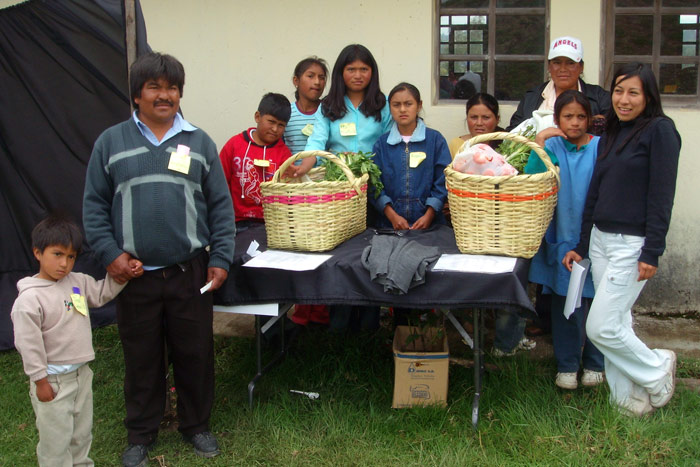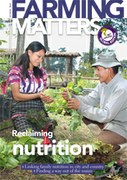Ecuador is going through a substantial nutritional transition. This, coupled with the paradox that rural families that produce food are often those most affected by undernutrition, shows the ironies of ‘modern’ food systems. It also highlights the importance of rural-urban linkages around family nutrition which can help to address such contradictions. This is what we see among families living in two rural villages, San Francisco Alto and Ambuqui, in the north of Ecuador, who through various strategies have managed to achieve healthy, diversified and nutritious diets.

In one of our first visits to Marcia and Marcelo’s family in San Francisco Alto more than ten years ago, lunch comprised of a large bowl of boiled unpeeled potatoes with a hard boiled egg, a pasta soup with a little bit of milk, and a glass of lemonade. In 2011, we ate kale soup with carrot, turnips and oca (an Andean tuber) rice with egg, tortilla with green vegetables, a cup of barley with milk, and boiled potatoes as a side dish. How their diet had become more diverse in a single decade!
Traditional to ‘modern’
But how did they get to such an undiversified diet in the first place? As with many farmers in the area starting in the 1980s, Marcelo’s family obtained some farm land following land reform. This change meant the family needed cash to pay for the necessary farming inputs and other emerging needs. Consequently, the family moved away from their traditional diversified production of Andean crops, including about a hundred species of tubers, vegetables and highly nutritious grains such as quinoa and chocho (the South American lupin, Lupinus mutabilis). Instead, they turned most of their land to growing a single, highly marketable variety of potato, superchola, with a shorter production cycle than most traditional Andean crops.
In the 1990s, there were large variations in potato prices. This was accompanied by decreasing yields due to soil degradation that in turn resulted from heavy mechanized tillage, and increased pest and disease attacks tied to monocropping. Over time, Marcelo’s family fell into debt. Yet, potatoes continued to be an important part of the culture and the main source of food for the family as well as of their income from sales to the local wholesale market.
Links to the city
Through friends in the capital city, Quito, Marcelo learned about a group of urban families who were buying fresh vegetables directly from farmers. This group was part of the El Carmen (‘community food baskets’) movement, known in Spanish as the canastas comunitarias or canastas. Started in the 1980s, the canastas had become active in every major city in Ecuador. The canastas purchase food in bulk to decrease costs, and recently became interested in buying directly from farmers to allow them to realise more benefits from their farming activities.

Marcelo contacted Anita, the coordinator of the El Carmen group, about the possibility to sell his family’s ‘clean’ pesticide-free potato. Anita invited Marcelo to visit the group and take part in its weekly collective purchase. Upon his return, Marcelo told us, “This was the first time I felt the handshake of the people who ate my potatoes!” But Marcelo did not know at the time about all of the changes that such direct sale would demand. Meanwhile, Anita said: “We decided to find direct producers like Marcelo, but when we asked for a variety of food crops, they only could provide us with one or two at the most.”
Increasing the variety
Motivated by these requests for diversity from the canasta group, Marcelo went back to his father’s practices of planting a mixed variety of potatoes in the same plot. And like his grandfather, Marcelo started to grow once again other traditional tuber crops such as mashua, melloco and oca. And together with Marcia, they started a pesticide-free vegetable garden. Marcia said, “When the canasta group requested more products, we only had potatoes, and we realised that it was a shame for us to buy food that our family used to produce in our own land.”
Regarding the new varieties of products in the canasta group, Anita has this to say:“At first we were not accustomed to eating all the different vegetables that we received every week in the basket. For instance, we mainly used to eat chola potato while Marcelo brought us capira, violeta, ratona and other varieties we had never heard about and which tasted differently. We also had to get used to different kinds of leaves; and we had cooking lessons with nutritionists and elders to learn how to cook with these varieties and to rescue traditional recipes.”
Esperanza and Renato
The importance of building relationships between producer and consumer step by step is also illustrated with the story of Renato and Esperanza. Renato has been a farmer all his life in Ambuquí, in the neighbourhood of San Clemente, Imbabura. He married Esperanza, a woman from the community, who had worked in Ecuador’s capital as domestic worker for many years. When she returned to San Clemente and married Renato, she had to learn all over again about her husband’s deep connections with the land. With time, she managed to do so, but never lost the desire to explore other options beyond farming, for herself and her family.
With her business skills and ability to interact with sophisticated consumers from larger urban areas, Esperanza focused on diversifying the family income. In addition to working the land with agroecological methods and minimal use of pesticides, she was selected to represent a food cooperative in agroecological fairs. She also began to run the cooperative shop in the city of Ambuqui. When Esperanza and Renato had children they needed extra income, and Esperanza rode a horse up the mountain to the town of Peñaherrera to sell their farm produce along with other items.
After the children left home, the situation changed again. Esperanza became ‘the person to go to’ when the occasional Peace Corps volunteer, intern, or researcher needed a temporary place to stay. Now, when they have produce to sell, which includes a variety of legumes, fruits, grains and vegetables, Esperanza visits her regular clients down in Ambuquí, house by house. Occasionally, buyers will knock on their door to buy produce directly. They have fixed clients with special requests who, unlike most people in Ambuqui Esperanza says “do not eat vegetables, only French fries or boiled potatoes, rice and fried eggs. They say they are not rabbits or guinea pigs so will not eat grass.”
Renato and Esperanza, however, consume a very varied and nutritious diet, which includes the common staples of potatoes, rice, and eggs, but also includes a variety of green vegetables, legumes, grains, tubers, and fruits. Esperanza is greatly concerned with being able to provide to her customers the nutrients that she presumes will not be available in other homes in San Clemente.
When summer comes and production dwindles, Esperanza sells cosmetic products to clients in distant villages and cities. Her children are now university graduates with professional jobs, and while they do not expect to become farmers, they do find ways to remain connected to their parents and to their land. One daughter studies in the United States and sends and brings seeds that Esperanza grows in her farm with special care. Two of Esperanza’s sisters live in Spain and return to Ecuador with amusing stories about their lives in Europe, but still crave the local speciality of roasted guinea pig with potatoes for lunch.
These are some of the urban-rural linkages that allow this couple to continue farming the land in spite of droughts, no subsidies or support from the local government for production, and a system that seems to be focussed on guaranteeing economic successes to middlemen and other market intermediaries.
The importance of direct connections
The rural population in the areas where these two families live is enduring social and economic pressure to reduce crop diversity, and consequently suffers a loss in the knowledge and ability to consume a diversified diet. Yet, by linking rural and urban families, various families maintained or even increased diversity in their diets in rural as well as in urban areas. This usually happened through direct interactions between farmers and urban dwellers or through recipes passed down via secondary means. And in particular, through direct linkages between producers’ and consumers’ organisations that learned to value diversity and long-established foods.
Although a high diversity of production does not necessarily translate into high levels of dietary diversity or better nutrition, consumers’ and producers’ organisations can play a pivotal role in providing experiential opportunities that help to increase on-farm biodiversity, while also strengthening the knowledge inherent in such processes and systems. The nutritional effects also seem very clear. Yet, more such relationships are needed for such constructive rural-urban linkages to become commonplace.
Myriam Paredes and Carla Guerrón Montero
Myriam Paredes Chauca works for FLACSO, Ecuador as a professor and researcher, and Carla Guerrón Montero is a professor for the University of Delaware in the United States.
Email: mcparedes@flacso.edu.ec and cguerron@udel.edu
This story builds on two previous articles: ‘Local food systems’ (Farming Matters, 29.2: 38-40) and ‘Building an urban-rural platform’ (LEISA Magazine, 24.3: 22-24).

